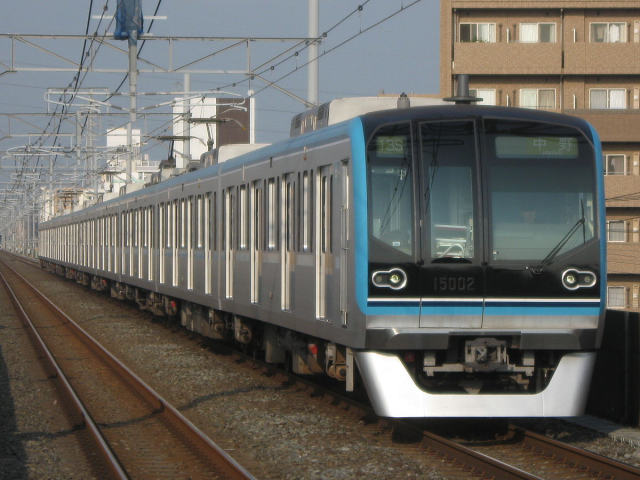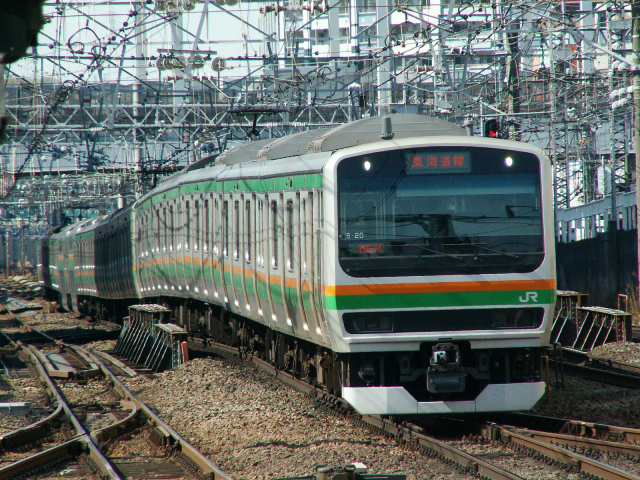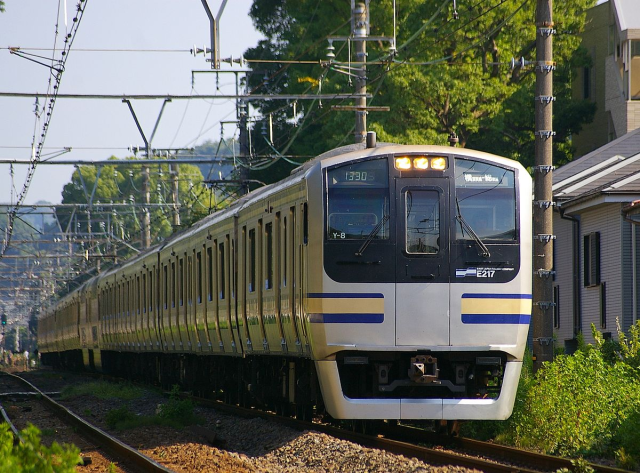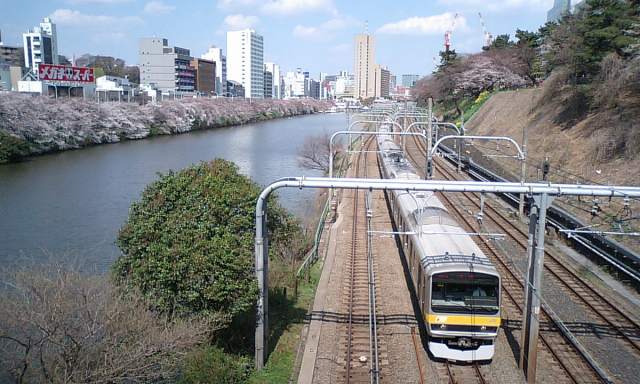
Tokyo’s trains are too crowded for just a top 10 list, and the worst is one that runs at almost double 100-percent capacity.
Measuring how crowded something is isn’t as simple as just counting the number of people present. For example, three people isn’t considered crowded in most environments, but it definitely would be if we were talking about, say, a public restroom stall.
So in order to calculate how crowded trains are, Japan’s Ministry of Land, Infrastructure, Transport and Tourism does a quick calculation. They count all the available seats on a train, add in the number of straps standing passengers can hold onto, and call that the standard, 100-percent capacity. Then they compare that to the number of people actually on the train during rush hour, and make sure they’ve got a cup handy so they can catch their eyeballs as they pop out of their skulls in shock at how far beyond 100 percent the trains are packed.
The ministry has just released the most recent results of its annual study, and the one bit of good news is only 11 train/subway lines (all which are in the Tokyo area) were over 180-percent capacity at rush hour, compared to 12 last year. On the other hand, that still means a ridiculously camped commute, so let’s take a look at the five most crowded:
5. Tokkaido Line: 187 percent
As with many lines on the list, the Tokkaido Line connects downtown Tokyo offices and outlying residential neighborhoods. The line runs through salaryman meccas of Tokyo, Shimbashi, and Shinagawa Stations and out to the cities of Kawasaki and Yokohama (Japan’s second-largest city) and then western Kanagawa and eastern Shizuoka Prefectures beyond.
4. Nambu Line: 189 percent
The Nambu Line may not reach the heart of Tokyo, but it runs diagonally along its southwest edge, connecting Kawasaki and Tachikawa Stations, a swath of land where some of the area’s most affordable housing is. It also connects to Musashi Kosugi Station in Kawasaki, from where trains run to both the west and east sides of downtown Tokyo.
3. Yokosuka Line: 196 percent
Like the Tokkaido Line, the Yokosuka Line’s last three stops are Tokyo, Shimbashi, and Shinagawa. At the other end, it runs through the town of Kawasaki and Yokohama, as well as historic Kamakura, beach-loving Zushi, and port town Kurihama, three cities where the price of a quiet lifestyle can sometimes be an aggravating commute into Tokyo.
2. Chuo-Sobu Line: 197 percent
So far, we’ve been looking at a lot of lines that connect Tokyo with communities to the south. The expansive Chuo Sobu Line, though, ties the city center into town to the east and west, with classy Kichijoji Mitaka (home of the Ghibli Museum) on one end, and Chiba Station, in Tokyo’s neighboring prefecture to the east, on the other. Like with the southern stops of the Yokosuka Line, these are fashionable and/or affordable places to live, but for work and school, residents hop on the Chuo Sobu Line to get to downtown’s Shinjuku, Iidabashi, Akihabara, and Ryogoku Stations.
1. Tokyo Metro Tozai Line: 199 percent
Finally, the most crowded rail line in all of Japan is actually a subway line (and yes, it’s designed as such — it’s not a train line that simply sank into the earth when it got too weighed down with passengers). The Tozai Line’s east/west endpoints are Nakano and Nishi-Funabashi, and stops between them include Takadanobaba and Waseda, home of one of downtown’s largest university campuses and multiple specialized schools, as well as Otemachi and Nihombashi, where several titans of the Japanese business and financial worlds have their main offices. Add in the fact that both Nakano and Nishi-Funabashi are transfer stations for the Chuo-Sobu line (the second-most crowded line), with some trains running straight through to the Chuo-Sobu, and it’s easy to see why it’s practically double-capacity on the Tozai at rush hour.
The remaining lines in the top 11 are:
6. Nippori Toneri Liner: 187 percent
7. Keihin Tohoku Line: 186 percent
8. Saikyo Line: 185 percent
9. Denentoshi Line: 185 percent
10. Chuo Rapid Line: 184 percent
11. Sobu Rapid Line: 18 percent
It’s also worth noting that aside from the Tozai, Nippori Toneiri, and Denentoshi Line, all the lines on the list are operated by Japan Railway (a.k.a. JR), so you might want to avoid them if you’re traveling on the all-inclusive JR pass. On the other hand, sometimes there’s no alternate route to get where you’re going, so all you can do is grit your teeth and accept the crowded trains as being one more part of the full Japan experience.
Source: Ministry of Land, Infrastructure, Transport and Tourism, Jiji via Jin
Top image: Wikipedia/DAJF
Insert images: Pakutaso, Wikipedia/STTrain, Wikipedia/Takasunrise0921, Wikipedia/本屋
Follow Casey on Twitter, where he used to ride the Tozai Line every day.





 A ranking of Tokyo’s 10 best train and subway lines for spotting handsome men
A ranking of Tokyo’s 10 best train and subway lines for spotting handsome men Tokyo subway bribes people with free noodles to get them to take earlier, non-rush hour trains
Tokyo subway bribes people with free noodles to get them to take earlier, non-rush hour trains Tokyo Metro adds platform display showing where least crowded parts of the next train will be
Tokyo Metro adds platform display showing where least crowded parts of the next train will be What’s the best part of Tokyo to live in, and why? Survey gives the top six picks
What’s the best part of Tokyo to live in, and why? Survey gives the top six picks Filled to bursting point? Rush-hour crush on Tokyo subway leaves train with broken window
Filled to bursting point? Rush-hour crush on Tokyo subway leaves train with broken window Japan’s new difficult-to-drink-from beer glass protects your liver, but it’s a brutal experience
Japan’s new difficult-to-drink-from beer glass protects your liver, but it’s a brutal experience Demon Slayer: Kimetsu no Yaiba gets new roller coaster attractions and food at Universal Studios Japan
Demon Slayer: Kimetsu no Yaiba gets new roller coaster attractions and food at Universal Studios Japan How to order snacks on a Shinkansen bullet train in Japan
How to order snacks on a Shinkansen bullet train in Japan Burger King Japan suddenly adds Dr. Pepper and Dr. Pepper floats to its menu nationwide
Burger King Japan suddenly adds Dr. Pepper and Dr. Pepper floats to its menu nationwide New Pokémon ice cream, dessert drinks, and cool merch coming to Baskin-Robbins Japan【Pics】
New Pokémon ice cream, dessert drinks, and cool merch coming to Baskin-Robbins Japan【Pics】 Caffeinated ramen for gamers that you can eat with one hand going on sale in Japan
Caffeinated ramen for gamers that you can eat with one hand going on sale in Japan New samurai glasses are Japan’s latest weird must-have souvenir
New samurai glasses are Japan’s latest weird must-have souvenir McDonald’s adds new watermelon frappe and fruity macaron to its menu in Japan
McDonald’s adds new watermelon frappe and fruity macaron to its menu in Japan Princesses, fruits, and blacksmiths: Study reveals the 30 most unusual family names in Japan
Princesses, fruits, and blacksmiths: Study reveals the 30 most unusual family names in Japan We check out the local flavors of the commonly confused Ome and Aomi areas of Tokyo in one day
We check out the local flavors of the commonly confused Ome and Aomi areas of Tokyo in one day Nintendo history you can feel – Super NES, N64, and GameCube controllers become capsule toys
Nintendo history you can feel – Super NES, N64, and GameCube controllers become capsule toys Hello, cosmetics! Clinique teams up with Hello Kitty this summer for first-time collaboration
Hello, cosmetics! Clinique teams up with Hello Kitty this summer for first-time collaboration “The most Delicious Cup Noodle in history” – Japan’s French Cup Noodle wins our heart【Taste test】
“The most Delicious Cup Noodle in history” – Japan’s French Cup Noodle wins our heart【Taste test】 Starbucks releases a cute Frappuccino and Unicorn Cake…but not in Japan
Starbucks releases a cute Frappuccino and Unicorn Cake…but not in Japan Kyoto Tower mascot termination reveals dark side behind cute Japanese characters
Kyoto Tower mascot termination reveals dark side behind cute Japanese characters McDonald’s Japan’s Soft Twist Tower: A phantom ice cream only sold at select branches
McDonald’s Japan’s Soft Twist Tower: A phantom ice cream only sold at select branches Yabai Ramen: What makes this Japanese ramen so dangerous?
Yabai Ramen: What makes this Japanese ramen so dangerous? Finally! Nintendo Japan expands Switch 8-bit controller sales to everybody, Online member or not
Finally! Nintendo Japan expands Switch 8-bit controller sales to everybody, Online member or not Japanese government wants to build luxury resorts in all national parks for foreign tourists
Japanese government wants to build luxury resorts in all national parks for foreign tourists To combat declining birth rate, Japan to begin offering “Breeding Visas” to foreigners
To combat declining birth rate, Japan to begin offering “Breeding Visas” to foreigners 10 things you should buy at 7-Eleven in Japan
10 things you should buy at 7-Eleven in Japan Studio Ghibli releases anime heroine cosplay dresses that are super comfy to wear
Studio Ghibli releases anime heroine cosplay dresses that are super comfy to wear Woman charged for driving suitcase without a license in Osaka
Woman charged for driving suitcase without a license in Osaka Studio Ghibli unveils My Neighbour Totoro miniature house model
Studio Ghibli unveils My Neighbour Totoro miniature house model Kyoto experiencing problems with foreign tourists not paying for bus fares, but not on purpose
Kyoto experiencing problems with foreign tourists not paying for bus fares, but not on purpose Fighting mild hunger with a Japanese soda that turns into jelly in the stomach【Taste test】
Fighting mild hunger with a Japanese soda that turns into jelly in the stomach【Taste test】 Studio Ghibli’s Howl’s Moving Castle tapestry unveiled in Japan for first time
Studio Ghibli’s Howl’s Moving Castle tapestry unveiled in Japan for first time McDonald’s new Happy Meals offer up cute and practical Sanrio lifestyle goods
McDonald’s new Happy Meals offer up cute and practical Sanrio lifestyle goods Sales of Japan’s most convenient train ticket/shopping payment cards suspended indefinitely
Sales of Japan’s most convenient train ticket/shopping payment cards suspended indefinitely Sold-out Studio Ghibli desktop humidifiers are back so Totoro can help you through the dry season
Sold-out Studio Ghibli desktop humidifiers are back so Totoro can help you through the dry season Japanese government to make first change to romanization spelling rules since the 1950s
Japanese government to make first change to romanization spelling rules since the 1950s Foreigner’s request for help in Tokyo makes us sad for the state of society
Foreigner’s request for help in Tokyo makes us sad for the state of society Ghibli founders Toshio Suzuki and Hayao Miyazaki contribute to Japanese whisky Totoro label design
Ghibli founders Toshio Suzuki and Hayao Miyazaki contribute to Japanese whisky Totoro label design Doraemon found buried at sea as scene from 1993 anime becomes real life【Photos】
Doraemon found buried at sea as scene from 1993 anime becomes real life【Photos】 Tokyo’s most famous Starbucks is closed
Tokyo’s most famous Starbucks is closed One passenger pusher isn’t enough for Tokyo area train that needs three-man team【Video】
One passenger pusher isn’t enough for Tokyo area train that needs three-man team【Video】 Commuter chaos at Shibuya Station after glass window breaks on door of crowded Japanese train
Commuter chaos at Shibuya Station after glass window breaks on door of crowded Japanese train Tokyo airport’s new train line to make getting into, out of the city easier for JR pass holders
Tokyo airport’s new train line to make getting into, out of the city easier for JR pass holders Spirited Away’s No-Face, Yubaba appear in seaside park in Japan as Ghibli museum exhibit opens 【Vid】
Spirited Away’s No-Face, Yubaba appear in seaside park in Japan as Ghibli museum exhibit opens 【Vid】 Commuter chaos around Tokyo during peak hour after Typhoon Trami hits Japan 【Pics & Video】
Commuter chaos around Tokyo during peak hour after Typhoon Trami hits Japan 【Pics & Video】 Is this Japanese train crowded? Question divides the nation
Is this Japanese train crowded? Question divides the nation The secret piece of information hiding in plain sight on Tokyo’s subway signs
The secret piece of information hiding in plain sight on Tokyo’s subway signs The 10 best places for young, single people to live in and around Tokyo【Survey】
The 10 best places for young, single people to live in and around Tokyo【Survey】 Japan has a Ghibli train where you can travel by the sea with Spirited Away’s No Face and Chihiro
Japan has a Ghibli train where you can travel by the sea with Spirited Away’s No Face and Chihiro Tokyo train delayed due to the strangest of reasons
Tokyo train delayed due to the strangest of reasons What should Tokyo’s newest rail station be called? Poll asks high school girls for their opinion
What should Tokyo’s newest rail station be called? Poll asks high school girls for their opinion “Passengers who don’t want to be groped, please use the rear train cars” announcement angers Japan
“Passengers who don’t want to be groped, please use the rear train cars” announcement angers Japan Tokyo adding free Wi-Fi to 143 subway stations for foreign travelers
Tokyo adding free Wi-Fi to 143 subway stations for foreign travelers “Men-only train car” to run in Tokyo as part of “Weak Men’s” association awareness campaign
“Men-only train car” to run in Tokyo as part of “Weak Men’s” association awareness campaign “We just wanted to see them stop!” Four train otaku arrested for throwing smoke bombs at trains
“We just wanted to see them stop!” Four train otaku arrested for throwing smoke bombs at trains
Leave a Reply